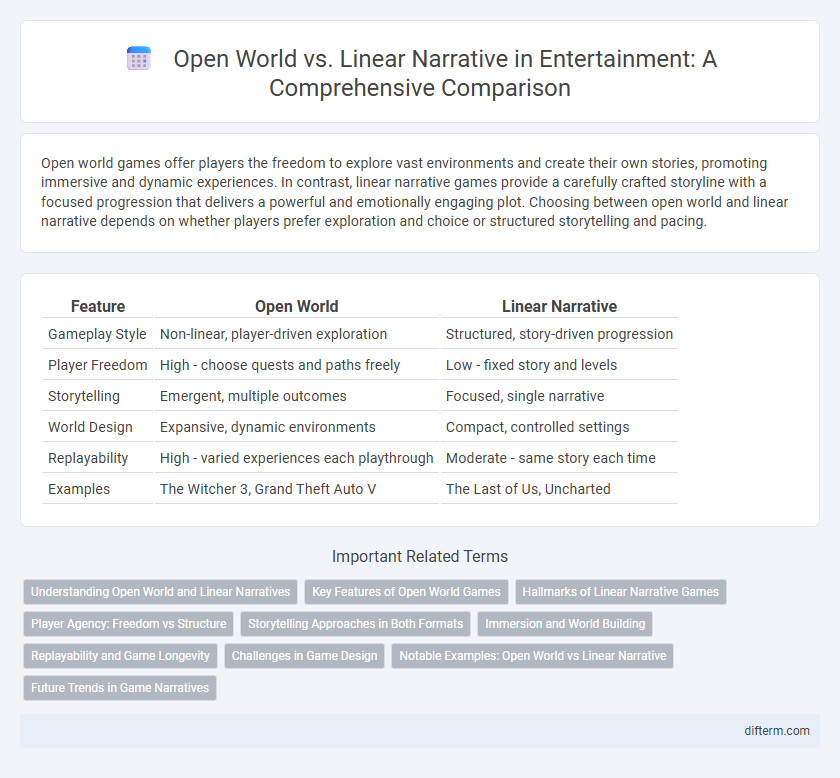Open world games offer players the freedom to explore vast environments and create their own stories, promoting immersive and dynamic experiences. In contrast, linear narrative games provide a carefully crafted storyline with a focused progression that delivers a powerful and emotionally engaging plot. Choosing between open world and linear narrative depends on whether players prefer exploration and choice or structured storytelling and pacing.
Table of Comparison
| Feature | Open World | Linear Narrative |
|---|---|---|
| Gameplay Style | Non-linear, player-driven exploration | Structured, story-driven progression |
| Player Freedom | High - choose quests and paths freely | Low - fixed story and levels |
| Storytelling | Emergent, multiple outcomes | Focused, single narrative |
| World Design | Expansive, dynamic environments | Compact, controlled settings |
| Replayability | High - varied experiences each playthrough | Moderate - same story each time |
| Examples | The Witcher 3, Grand Theft Auto V | The Last of Us, Uncharted |
Understanding Open World and Linear Narratives
Open world narratives offer players expansive environments that emphasize exploration and player-driven storytelling, providing freedom to interact with diverse characters and quests at their own pace. Linear narratives guide players through a predetermined story arc with focused pacing and structured events, ensuring a cohesive and tightly woven plot experience. Understanding the core mechanics and design goals of open world and linear narratives enhances appreciation of their distinct storytelling methods and player engagement styles.
Key Features of Open World Games
Open world games feature expansive, non-linear environments that allow players to explore vast landscapes and complete objectives in any order, fostering a sense of freedom and immersion. These games often include dynamic weather systems, day-night cycles, and interactive NPCs that contribute to a living, breathing world. Player agency and emergent gameplay are central, enabling multiple approaches to challenges and personalized storytelling experiences.
Hallmarks of Linear Narrative Games
Linear narrative games are characterized by a structured storyline with predetermined events and fixed player choices, emphasizing a tightly controlled plot progression. These games often feature strong character development, cinematic storytelling, and clear objectives guiding the player through a cohesive experience. Examples include titles like The Last of Us and Uncharted, where the emphasis is on delivering a compelling, scripted narrative rather than exploratory freedom.
Player Agency: Freedom vs Structure
Open world games offer expansive environments where player agency drives exploration and decision-making, allowing for multiple paths and outcomes. Linear narrative games provide a structured storyline with predetermined sequences, ensuring a focused and emotionally crafted experience. The contrast lies in freedom versus directed storytelling, shaping player engagement and immersion differently in each format.
Storytelling Approaches in Both Formats
Open world games emphasize player agency by allowing exploration and non-linear storytelling, weaving narratives through environmental details, quests, and character interactions that adapt to player choices. Linear narrative games concentrate on a tightly controlled story arc with predetermined events and character developments, offering a cohesive and immersive experience guided by the developers' vision. Both formats leverage unique storytelling techniques: open world fosters emergent narratives shaped by gameplay freedom, while linear narratives prioritize polished, impactful storytelling with a clear beginning, middle, and end.
Immersion and World Building
Open world games offer expansive environments rich with interactive elements, fostering deep immersion through player-driven exploration and dynamic world-building. Linear narrative experiences deliver tightly crafted storylines that guide players through emotionally resonant moments, enhancing immersion via focused storytelling and character development. The choice between open world and linear narratives significantly impacts how players engage with the game's universe and experience its thematic depth.
Replayability and Game Longevity
Open world games excel in replayability and game longevity by offering expansive environments and diverse side quests that encourage exploration and multiple playthroughs. Linear narrative games deliver a tightly controlled story experience but often have limited replay value due to predetermined plot progression. Players seeking extended engagement and varied gameplay typically prefer open world titles for their dynamic content and emergent storytelling.
Challenges in Game Design
Designing open world games demands intricate world-building and dynamic systems to maintain player engagement across vast environments, presenting challenges in pacing and content density. Linear narrative games require meticulous scripting and level design to deliver a tightly controlled, emotionally impactful story, but risk limiting player agency. Balancing freedom in open worlds with meaningful storytelling remains a core challenge for developers striving to create immersive and cohesive gaming experiences.
Notable Examples: Open World vs Linear Narrative
Notable examples of open world games like The Legend of Zelda: Breath of the Wild and Grand Theft Auto V showcase vast, explorable environments with player-driven story progression, contrasting sharply with linear narrative titles such as The Last of Us and Uncharted, which offer tightly controlled storylines and cinematic experiences. Open world games emphasize player freedom and emergent storytelling, while linear narratives prioritize scripted events and emotional impact. These distinctions highlight divergent design philosophies that cater to different player preferences within the entertainment industry.
Future Trends in Game Narratives
Future trends in game narratives emphasize the integration of open world environments with dynamic storytelling that adapts to player choices, enhancing immersion and replayability. Advanced AI-driven characters and procedural content generation enable more personalized and evolving storylines outside traditional linear frameworks. This fusion of freedom and narrative depth is shaping the next generation of interactive entertainment experiences.
Open World vs Linear Narrative Infographic

 difterm.com
difterm.com